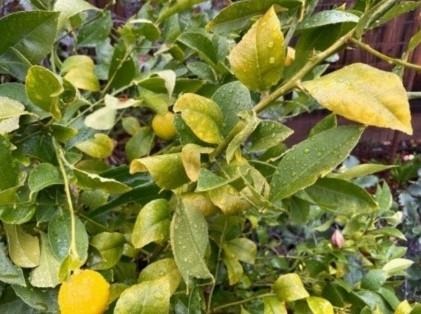Are you noticing that the leaves on your citrus trees are looking yellow, and wondering if now is the time to fertilize? We have some answers for you.

Winter yellowing on lemon leaves.
Should You Fertilize Now?
First of all, don't be too worried about the yellow leaves. The yellowing, especially the yellowing of the leaf veins, is related to a lack of nitrogen. Citrus leaves are frequently yellow in the winter due to the trees' inability to take up nitrogen in cold weather. But now, as the days get longer and the soil begins to warm, the trees are getting ready to pick up nitrogen from the soil which means we are getting closer to the start of the citrus tree fertilization process.
Citrus trees are typically fertilized at three points in the year. The first is in January or February just before the trees begin to bloom. Exactly when will depend on your microclimate and the trees' readiness. Given the climate differences In Contra Costa County, you may need to apply the first fertilizer in late January, while the trees in central and east county may not be ready until mid- to late-February.
The next application time is in May, with a third application in June if necessary. And that is it for the season. Avoid fertilizing any later in the year, since late-season fertilization can have adverse effects on the fruits, including reduced fruit quality, delayed fruit coloring, and rough rinds. Late-season fertilization can also cause off-season growth making the trees more susceptible to diseases, disorders, and pests. Frost damage and leaf miner infestations are two common problems with late-season fertilization.
What Kind of Fertilizer Should You Apply?
Nitrogen is the main nutrient that you need to provide. Contra Costa soils are typically deficient in nitrogen and citrus trees are heavy nitrogen users. There are many sources of nitrogen. An easy choice for the home gardener is an organic citrus fertilizer. Fertilizers are labeled with three numbers on the front of the package, indicating percentages of N (nitrogen), P (phosphorous) and K (potassium). Look for a fertilizer where the first number (nitrogen) is the highest of the three, e.g., 7-3-3.
Citrus can also suffer from micronutrient deficiencies including zinc or iron. Most organic fertilizers contain these micronutrients, but if the leaves on your citrus have yellow patches between green veins you may need to correct these deficiencies by applying a foliar application of a liquid chelated micronutrient solution as the new growth emerges in the spring.
You can check here on the signs of different nutrient deficiencies to get an idea of what you are dealing with: https://ipm.ucanr.edu/PMG/C107/m107bpleaftwigdis.html
No matter which product you are applying, make sure that you carefully follow all label directions on the amounts and timing of the fertilizer application. Avoid over fertilizing which can cause excessive new growth, making the trees susceptible to other disorders such as bacterial blast.
Micronutrient deficiencies can also occur if the soil is too acidic or too alkaline. Citrus trees can tolerate a pH in the range of 6.0-7.5, with 6.5 being optimum. Contra Costa soils tend to be on the higher, alkaline side. If you have taken the actions above and are still not seeing the results you want, a soil pH test may be your next step. You can use an off-the-shelf home soil test kit or send a soil sample to a commercial soil test company.
How Should You Apply the Fertilizer?
The fertilizer should be scattered evenly on the soil under the tree's canopy. Make sure that you distribute the fertilizer at least as far out as the drip line. Avoid the area near the trunk. Lightly scratch the fertilizer into the surface of the soil and then irrigate.
Source : ucanr.edu